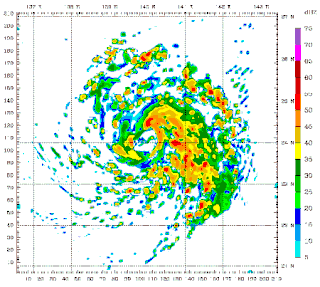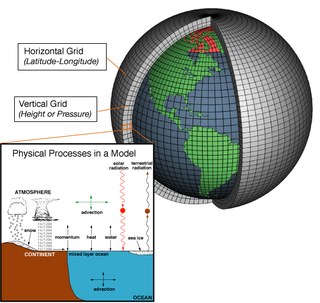Related Research Articles

Computational physics is the study and implementation of numerical analysis to solve problems in physics for which a quantitative theory already exists. Historically, computational physics was the first application of modern computers in science, and is now a subset of computational science. It is sometimes regarded as a subdiscipline of theoretical physics, but others consider it an intermediate branch between theoretical and experimental physics - an area of study which supplements both theory and experiment.

Computational fluid dynamics (CFD) is a branch of fluid mechanics that uses numerical analysis and data structures to analyze and solve problems that involve fluid flows. Computers are used to perform the calculations required to simulate the free-stream flow of the fluid, and the interaction of the fluid with surfaces defined by boundary conditions. With high-speed supercomputers, better solutions can be achieved, and are often required to solve the largest and most complex problems. Ongoing research yields software that improves the accuracy and speed of complex simulation scenarios such as transonic or turbulent flows. Initial validation of such software is typically performed using experimental apparatus such as wind tunnels. In addition, previously performed analytical or empirical analysis of a particular problem can be used for comparison. A final validation is often performed using full-scale testing, such as flight tests.

Computer simulation is the process of mathematical modelling, performed on a computer, which is designed to predict the behaviour of, or the outcome of, a real-world or physical system. The reliability of some mathematical models can be determined by comparing their results to the real-world outcomes they aim to predict. Computer simulations have become a useful tool for the mathematical modeling of many natural systems in physics, astrophysics, climatology, chemistry, biology and manufacturing, as well as human systems in economics, psychology, social science, health care and engineering. Simulation of a system is represented as the running of the system's model. It can be used to explore and gain new insights into new technology and to estimate the performance of systems too complex for analytical solutions.

Numerical weather prediction (NWP) uses mathematical models of the atmosphere and oceans to predict the weather based on current weather conditions. Though first attempted in the 1920s, it was not until the advent of computer simulation in the 1950s that numerical weather predictions produced realistic results. A number of global and regional forecast models are run in different countries worldwide, using current weather observations relayed from radiosondes, weather satellites and other observing systems as inputs.
A direct numerical simulation (DNS) is a simulation in computational fluid dynamics (CFD) in which the Navier–Stokes equations are numerically solved without any turbulence model. This means that the whole range of spatial and temporal scales of the turbulence must be resolved. All the spatial scales of the turbulence must be resolved in the computational mesh, from the smallest dissipative scales, up to the integral scale , associated with the motions containing most of the kinetic energy. The Kolmogorov scale, , is given by
CFD-ACE+ is a commercial computational fluid dynamics solver developed by ESI Group. It solves the conservation equations of mass, momentum, energy, chemical species and other scalar transport equations using the finite volume method. These equations enable coupled simulations of fluid, thermal, chemical, biological, electrical and mechanical phenomena.

Airflow Sciences Corporation (ASC) is an engineering consulting company based in Livonia, Michigan, USA that specializes in the design and optimization of equipment and processes involving flow, heat transfer, combustion, and mass transfer. Engineering techniques include Computational Fluid Dynamics (CFD) modeling, experimental laboratory testing, and field measurements at client sites. ASC works for a wide range of industries world-wide, including power generation, manufacturing, aerospace, HVAC, food processing, biomedical, pollution control, oil & gas, rail, legal, and automotive.
A CFD-DEM model is suitable for the modeling or simulation of fluid-solids or fluid-particles systems. In a typical CFD-DEM model, the phase motion of discrete solids or particles is obtained by the Discrete Element Method (DEM) which applies Newton's laws of motion to every particle and the flow of continuum fluid is described by the local averaged Navier–Stokes equations that can be solved by the traditional Computational Fluid Dynamics (CFD). The model is first proposed by Tsuji et al. The interactions between the fluid phase and solids phase is better modeled according to Newton's third law.
Specialized wind energy software applications aid in the development and operation of wind farms.
Wind resource assessment is the process by which wind power developers estimate the future energy production of a wind farm. Accurate wind resource assessments are crucial to the successful development of wind farms.
The multiphase particle-in-cell method (MP-PIC) is a numerical method for modeling particle-fluid and particle-particle interactions in a computational fluid dynamics (CFD) calculation. The MP-PIC method achieves greater stability than its particle-in-cell predecessor by simultaneously treating the solid particles as computational particles and as a continuum. In the MP-PIC approach, the particle properties are mapped from the Lagrangian coordinates to an Eulerian grid through the use of interpolation functions. After evaluation of the continuum derivative terms, the particle properties are mapped back to the individual particles. This method has proven to be stable in dense particle flows, computationally efficient, and physically accurate. This has allowed the MP-PIC method to be used as particle-flow solver for the simulation of industrial-scale chemical processes involving particle-fluid flows.

Flexcom is a finite element analysis software package used in the offshore oil and gas and marine renewable energy industries. An educational version is also available for universities.
CFD stands for computational fluid dynamics. As per this technique, the governing differential equations of a flow system or thermal system are known in the form of Navier–Stokes equations, thermal energy equation and species equation with an appropriate equation of state. In the past few years, CFD has been playing an increasingly important role in building design, following its continuing development for over a quarter of a century. The information provided by CFD can be used to analyse the impact of building exhausts to the environment, to predict smoke and fire risks in buildings, to quantify indoor environment quality, and to design natural ventilation systems.

Gerris is computer software in the field of computational fluid dynamics (CFD). Gerris was released as free and open-source software, subject to the requirements of the GNU General Public License (GPL), version 2 or any later.
Transition modeling is the use of a model to predict the change from laminar and turbulent flows in fluids and their respective effects on the overall solution. The complexity and lack of understanding of the underlining physics of the problems makes simulating the interaction between laminar and turbulent flow to be difficult and very case specific. Transition does have the wide range of turbulence options available for most computational fluid dynamics (CFD) applications for the following reasons:
Computational fluid dynamics (CFD) are used to understand complex thermal flow regimes in power plants. The thermal power plant may be divided into different subsectors and the CFD analysis applied to critical equipment/components - mainly different types of heat exchangers - which are of crucial significance for efficient and trouble free long-term operation of the plant.

Flowmaster Ltd. was a leading British Engineering Simulation Software company based in Towcester, UK. Its flagship 1D CFD product, also named ‘Flowmaster’, was first released commercially in 1987 although initial versions went back to the early 1980s having originated from BHRA, the not-for-profit British Hydromechanics Research Association, later to become the BHR Group.
Meteodyn WT, commonly known as Meteodyn is a wind energy software program that uses computational fluid dynamics (CFD) to conduct wind resource assessment. Developed and marketed by Meteodyn, Meteodyn WT was first released in September 2009. The software quantifies the wind resource in a desired terrain in order to assess the feasibility of a proposed wind farm. The software's objective is to design the most profitable wind farm. This is achieved by taking into account the measured wind data at a measurement tower and the terrain conditions. Both of these are essential to be able to obtain the wind conditions and therefore the wind resources of the desired terrain.

Fotis Sotiropoulos is a Greek-born American engineering professor and university administrator known for his research contributions in computational fluid dynamics for river hydrodynamics, renewable energy, biomedical and biological applications. He currently serves as the Provost and Senior Vice President for Academic Affairs of Virginia Commonwealth University, a position he has held since August 1, 2021
References
- ↑ Gameiro Lopes, Antonio M. (2003). "WindStation – A software for the simulation of atmospheric flows over complex topography" (PDF). Environmental Modelling & Software. 18 (1): 81–86. doi:10.1016/S1364-8152(02)00024-5.
- 1 2 3 4 5 6 Gameiro Lopes, Antonio M. (2019). WindStation – Version 1.3.23 – User's manual. menzio GmbH.
- ↑ "TR6 conform, bankable wind and energy yield assessments". www.menzio.de. Retrieved 2019-04-15.
- 1 2 3 4 "WindStation CFD". www.menzio.de. Retrieved 2019-04-15.
- ↑ Gameiro Lopes, A. M.; Sousa, A. C. M.; Viegas, D. X. (1995). "Numerical Simulation of Turbulent Flow and Fire Propagation in Complex Terrain" (PDF). Numerical Heat Transfer. Part A (27): 229–253.
- ↑ Gameiro Lopes, A. M.; Ribeiro, L. M.; Viegas, D. X. (2005). Application of Computer Models to the Prediction of Wildland Fire Behaviour and Environmental Impact. 3rd Dubrovnik Conference on Sustainable Development of Energy, Water and Environment Systems. Dubrovnik, Croatia.
- ↑ Gameiro Lopes, A. M.; Cruz, M. G.; Viegas, D. X. (2002). "FireStation – An Integrated Software System for the Numerical Simulation of Wind Field and Fire Spread on Complex Topography". Environmental Modelling & Software. 17 (3): 269–285. doi:10.1016/S1364-8152(01)00072-X.
- ↑ Moore, G.; Paine, R. J.; Gameiro Lopes, A. M. (March 2013). Practical Uses of the WindStation Computational Fluid Dynamics (CFD) Model in Air Quality Dispersion Studies. Air & Waste Management Association's Specialty Conference Guideline on Air Quality Models: The Path Forward. Raleigh, North Carolina.
- ↑ Alé, J. A. V.; Oliveira, C. P.; François, D. E.; Gameiro Lopes, A. M. (2011). Wind Resource of Microregions in South and Northeast of Brazil: An Evaluation of Meteorological Data and Computational Tool. EWEA 2011 – Europe's Premier Wind Energy Event. Belgium.
- ↑ Gameiro Lopes, A. M.; Herrera Sánchez, O.; Sperling, T.; Daus, R.; Braun, R. (2017). "Prediction of the wind field in moderate terrain using the Navier-Stokes solver WindStation". 13th German Wind Energy Conference : proceedings. DEWEK 2017 13th German Wind Energy Conference : proceedings. Bremen, Germany.
- ↑ Lopes Duarte, N. G.; Gameiro Lopes, A. M.; Herrera Sanchez, O. (2018). Teste de modelos de simulação do campo de ventos para aplicações de avaliação do potencial eólico (PDF) (Master Thesis: University of Coimbra).
- ↑ Gameiro Lopes, A. M.; Duarte, N. G. L.; Herrera Sánchez, O.; Daus, R.; Koch, H. (2021). "Numerical Prediction of the Boundary-Layer Flow Over the Bolund Hill: Assessment of Turbulence Models and Advection Schemes". Boundary-Layer Meteorology. 180: 27–52. doi:10.1007/s10546-021-00613-5. S2CID 233330672.
- ↑ Nunes Vicente, A. H. S.; Gameiro Lopes, A. M.; Herrera Sanchez, O. (2018). Validation of wind turbine wake models (Master Thesis: University of Coimbra).
- ↑ Gameiro Lopes, A. M.; Vincente, A. H. S. N.; Herrera Sánchez, O.; Daus, R.; Koch, H. (2022). "Operation assessment of analytical wind turbine wake models". Journal of Wind Engineering and Industrial Aerodynamics. 220.